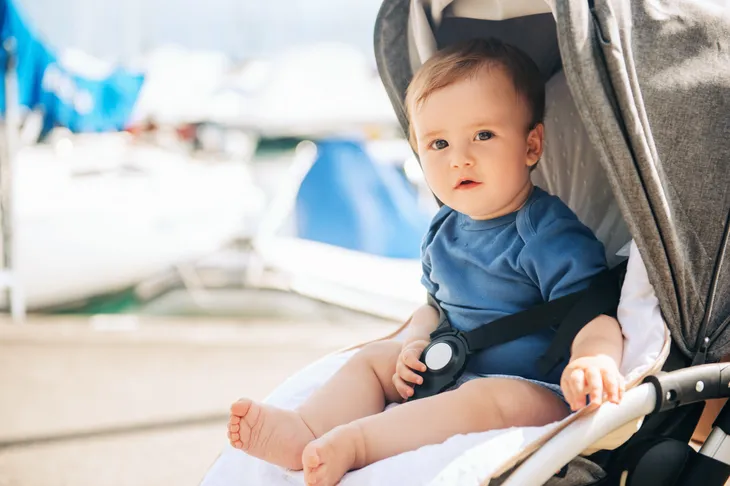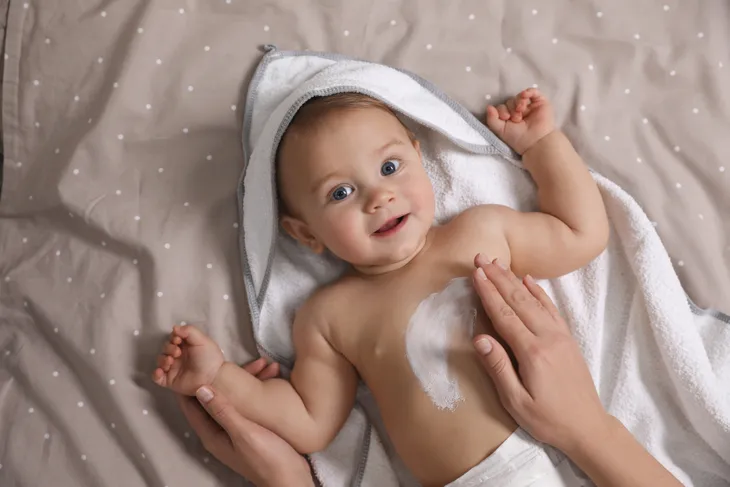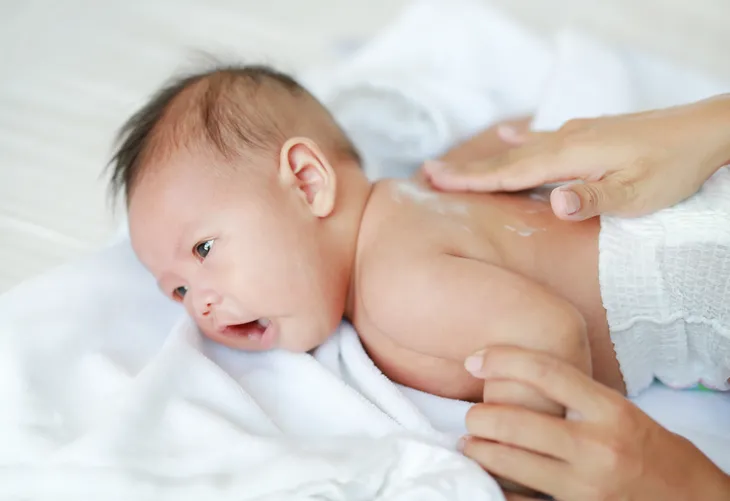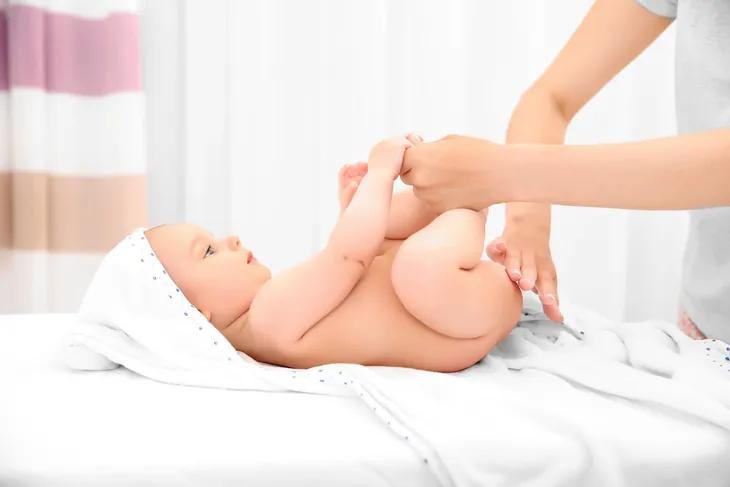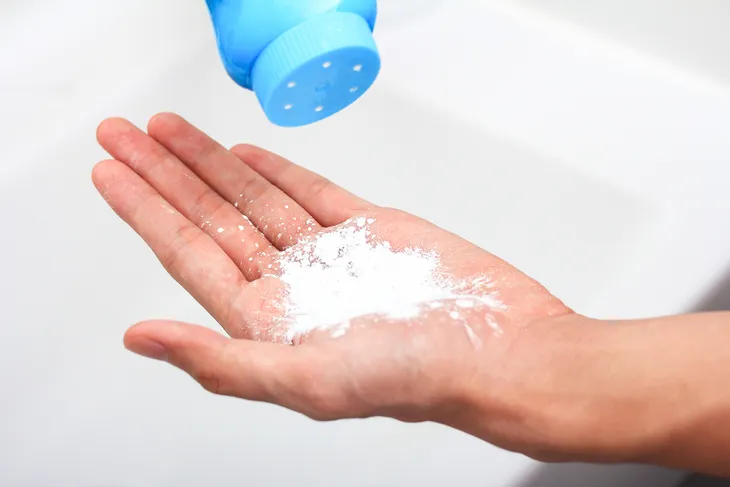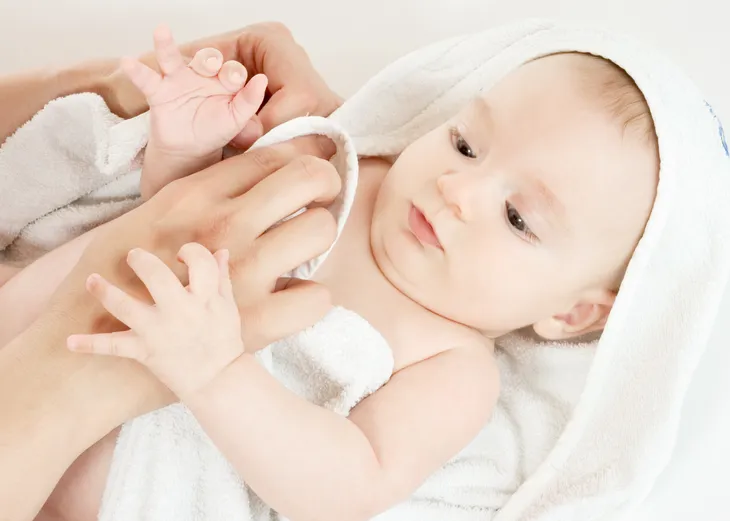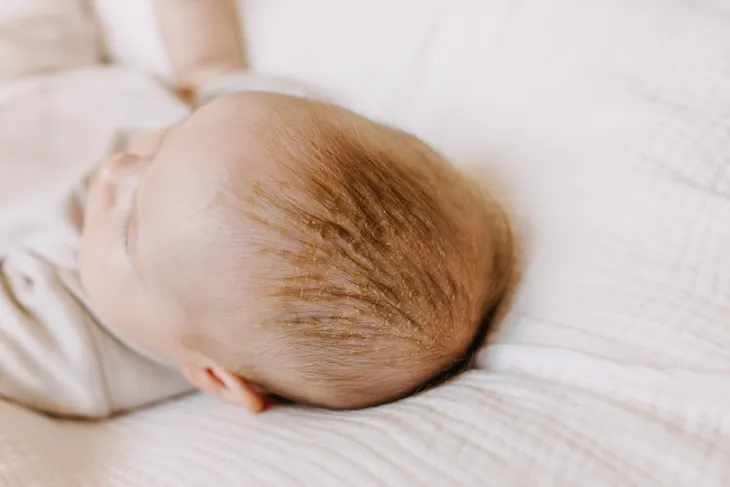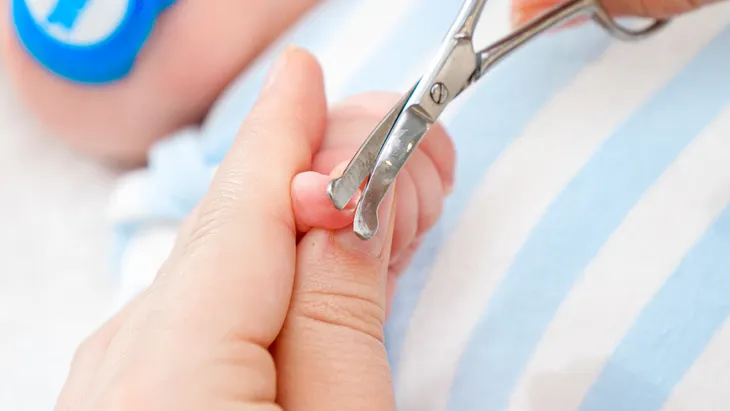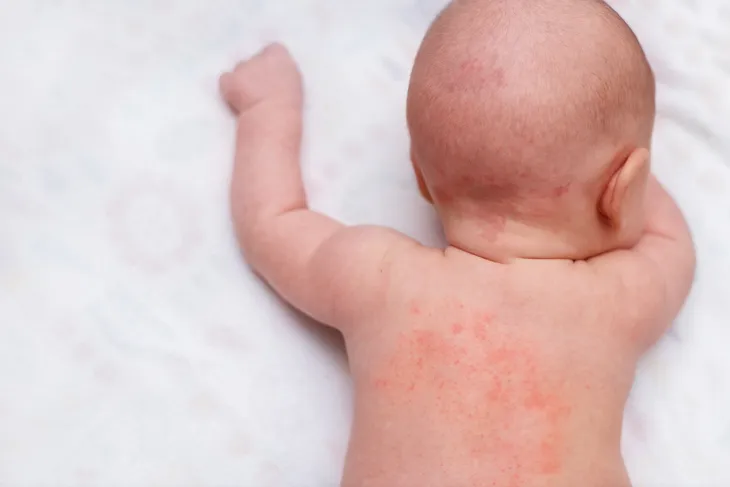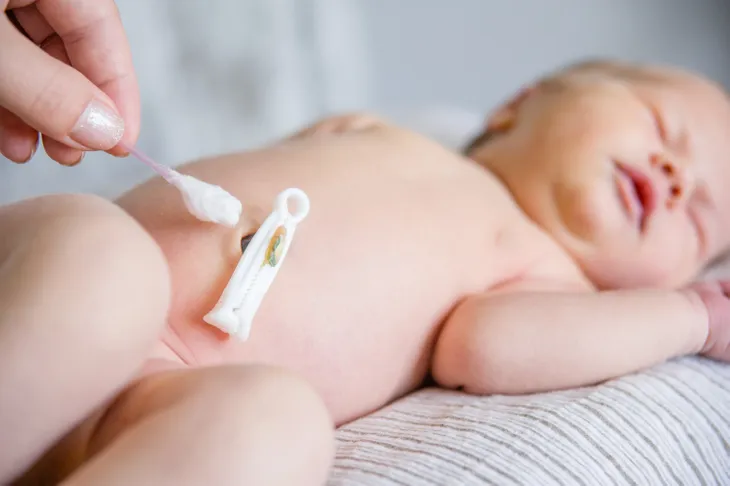- Babies skin is thinner than adults which makes it more susceptible to allergens and irritants, leading to rashes, blemishes, and even infections.
- There are many important things parents should do to protect their baby’s skin. One of the most important is to stay out of the sun and heat, and keep them nice and cool.
- Change their diapers frequently, apply diaper cream when needed, avoid bathing with soap every day, use gentle products, and moisturize their skin after baths.
- Parents should also manage baby’s nail growth to avoid scratches, keep the umbilical cord clean and dry until it falls off, and monitor any moles or birth marks.
Babies have the most soft, buttery skin. They enter this world with a clean slate of perfect looking skin. But what make their skin so amazing is also what makes it so fragile. According to Parents, their skin is thinner and more fragile than adults. This makes them more susceptible to allergens and irritants, which leads to rashes, blemishes, and even infections.
While some of these things are hard to avoid, it’s still important for parents to take extra precaution when caring for their baby’s skin. To do so, follow these 12 tips on how to protect their skin…
Keep Baby Out of Sun
We should all be cautious with our skin when it comes to sun exposure, but this is especially important with babies. Parents should limit a baby’s time spent in the sun as much as possible, only exposing them when necessary. You can still take them outdoors, just try to keep them in the shade or covered. Healthline notes this even pertains to the winter months.
Guidelines by the Food and Drug Administration (FDA) state that a baby under the age of 6-months should be kept in the shade as much as possible and wear hats that cover their neck and ears. To keep them from overheating and out of the sun, dress them in loose fitting clothes that cover their arms and legs. Also, limit their sun exposure between 10 a.m. and 4 p.m. and keep them well hydrated with either formula or breastmilk.
Another important note as recommended by the American Academy of Pediatrics (AAP), do not put sunscreen on babies under 6-months-old. The best form of protection for them is to keep them covered up and out of the sun.
Use Gentle Products
Baby’s skin is very sensitive. They’re skin is thinner than adults and absorbs more products than we do so it’s important we avoid using harsh chemicals. Follow a “less is more” approach when it comes to baby products and choose products that have the fewest ingredients, says Parents.
The same source recommends choosing products that are free of dyes, preservatives, and fragrances. They also warn that just because a product says “unscented,” it doesn’t mean fragrance-free. Patrick McMahon, MD, a pediatric dermatologist and medical director of teledermatology at Children’s Hospital of Philadelphia tells Parents that some unscented products still have a masking fragrance to hide the chemical scent of the substance. These can still be irritating to children’s skin so look for “fragrance-free” over “unscented.” Even when using natural products, the less ingredients the better.
Bathing Tips for Baby
Contrary to popular belief, babies do not need to be bathed every day. Obviously, we need to keep them clean, but realistically they don’t get that dirty (aside from mishaps in the diaper) during those first couple months. They don’t have the hormones, sweating, or oils that adults have to make them smelly, so it’s not necessarily to scrub them down with soap on a daily basis. Parents should follow their best judgement about regular baths, but don’t need to do them every day.
To keep them clean between baths, Healthline suggests using a soft washcloth with lukewarm water to keep their face, genitals, and other body parts clean. Other important bathing tips provided by Healthline are to wash their eyes and face with water only, use lukewarm water (not hot), keep baths short (5 to 10-minutes), use fragrance and dye-free soap, and never leave them unattended.
Moisturize Dry Skin
While it’s true, babies have the softest skin, they can also get really dry skin. It’s often present on babies that are born late. WebMD assures parents not to worry! Underneath is lots of healthy, soft, moist skin. In fact, most babies will develop small patches of dry skin in those first few weeks after coming home, notes Healthline. Oftentimes they go away on their own.
However, if their skin is starting to become so dry that it cracks, Healthline suggests applying a small amount of moisturizing lotion (one that is free of perfumes and dyes) or a petroleum-jelly based product. Apply moisturizer about once a day after a bath (for a child without eczema) to lock in moisture and keep their skin nice and healthy, says Parents.
To prevent dry skin, parents can apply moisturizer after baths. You don’t need much, just a teaspoon. But this will help keep their skin from drying out.
Lather on Diaper Cream
The best way to prevent a diaper rash is to change diapers frequently. Diaper rash cream is also essential. And don’t be modest with it! This is especially important if they already have a diaper rash. Before applying the cream, gently clean the area with water or a fragrance-free baby wipe. Blot it dry, then apply the cream.
Diaper cream is the first line of defence between a baby’s bottom and their diaper. It acts as a barrier between their skin and any pee or poop. To prevent diaper rashes, WebMD recommends changing their diaper often, even if it’s just wet. Make sure the area is dry before applying diaper cream or a diaper. Also, make sure their diaper fits properly and isn’t too snug or too loose. When possible, let them have some naked time to air it out.
The last thing to note is that babies will sometimes get diaper a rash even when we follow all these rules. It should clear up with the proper care, but if it gets worse and doesn’t go away after 2 or 3 days, contact their doctor.
Don’t Use Baby Powder
While baby powder was quite commonly used back in the day, it’s no longer recommended. In fact, parents are asked not to use it because babies can inhale the fine grains of talcum powder or larger particles of cornstarch, warns WebMD. This can result in lung problems.
“If you have to use powder, shake the powder into your hands as far away from the baby, clap your hands together to remove excess powder, and apply a thin layer to your baby’s skin,” says Karl Neumann, MD, a pediatrician at Forest Hills Pediatric Associates to the Bump. Get their bum nice and dry by patting the area with a clean towel.
Clean and Dry All Their Folds
This has already been mentioned a couple times throughout the article, but it’s important to keep baby’s skin nice and dry. Oftentimes, babies have lots of little folds and creases where moisture likes to hide. Parents should be vigilant about wiping down these areas after a bath and throughout the day if they are in warm weather.
Pediatrician Cheryl Wu, MD, told the Bump that moisture can get stuck in the folds of baby’s skin. These areas are made up of thin, irritable skin that are especially prone to rashes. Keep a close eye on the folds in the neck area after the age of 3-months-old when babies start to drool and enter into a more oral phase. “To prevent redness, chaffing and peeling clean all of baby’s nooks twice a day,” writes the source. Wu also recommends cleaning the area with water to ensure there is no leftover food or milk hiding in there. Continuously wipe their mouth and make sure they wear a bib when eating.
How to Treat Cradle Cap
It’s not uncommon for babies to develop cradle cap, also called seborrheic dermatitis. According to WebMD, it’s caused in part by too much oil and shows up as “a scaly, waxy, red rash on the scalp, eyebrows, eyelids, the sides of nose, or behind the ears.” Cradle cap often occurs between 3-weeks-old and 3-months, says Healthline.
Most of the time cradle cap clears up on its own, but parents can help speed the process along by applying a small amount of emollient (mineral oil) to the affected area before washing their scalp with a gentle shampoo, explains Healthline. You should see improvements within a couple of washes. If you don’t, talk to your doctor about other potential treatments.
Manage Their Nail Growth
Many parents least favorite thing to do is trim their baby’s nails. It can be quite anxiety inducing, especially those first couple times! While their nails are certainly small and thin, they can be sharp and do damage to their face or body. Keep a close eye on their nail length. Trim them when needed.
Baby’s nails grow quite fast so they may need to be filed or cut every week, or even more often, says Healthline. There are many products available to parents for nail maintenance. If filing, use a non-metal nail file that can gently smooth and shorten their nails. There are also baby nail clippers. The same source recommends trimming their nails when they are asleep or very relaxed. This will help prevent any sudden jerking that could cause them injury.
Avoid Heat Rash
Similar to adults, infants can develop a heat rash. Parents should try to keep their baby cool and out of the sun to prevent this type of rash that occurs when they become overheated. According to Healthline, heat rashes tend to occur in areas where clothes rub against the skin and near skin folds. It’s more noticeable in babies with fair skin.
“Heat rash occurs when the sweat glands become blocked. Hot and humid weather, oils, or other ointments can cause the sweat glands to become overworked or blocked, leading to a rash,” writes the source. WebMD adds that it appears as small pinkish-red bumps in areas that are prone to sweating like armpits, diaper area, neck, and skin folds.
Keep Umbilical Cord Clean and Dry
One thing new parents might not know is that babies still have a small piece of the umbilical cord attached to their belly button after birth. According to Healthline, it typically falls off within 1 to 3-weeks and in the mean time parents need to keep it as clean and dry as possible.
Never pull the umbilical cord off or try to force it off. The source notes that it will fall off on its own. Do not apply any substances to it – not even rubbing alcohol – to prevent infection or speed up the drying process. Healthline warns that parents should call their baby’s doctor if they notice pus coming from the umbilical cord, redness or swelling, a foul smelling discharge, large amounts of bleeding, or if their baby develops a fever of 100-degrees Fahrenheit or higher.
Monitor Birthmarks
It’s not uncommon for children to be born with moles or birthmarks. In fact, WebMD states that more than 1 in 10 babies are born with birthmarks. A birthmark is any kind of skin discoloration that is not inherited. They might be present at birth or develop a few months later. For the most part, birthmarks are nothing to worry about and require no treatment, says the source.
However, if they are born with even just one mole, they should be checked by a dermatologist or pediatric dermatologist at least once a year, says Ana M. Duarte, MD, director of dermatology at Nicklaus Children’s Hospital and founder of the Children’s Skin Center in Miami when talking to Parents. Between these visits, parents should keep a watchful eye on these moles. Take note of whether new ones show up or if the existing mole changes in size, shape, or color.

